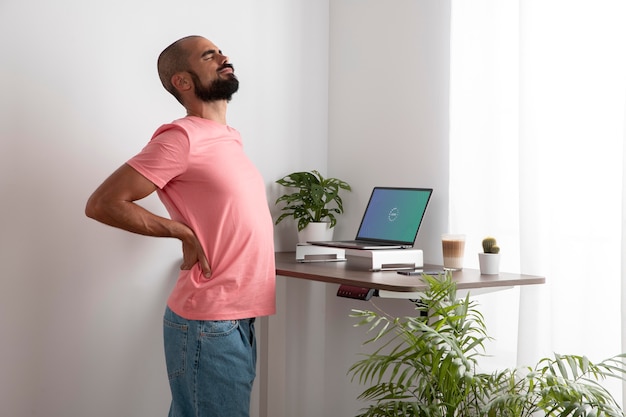Ask Ayurvedic doctor a question and get a consultation online on the problem of your concern in a free or paid mode. More than 2,000 experienced doctors work and wait for your questions on our site and help users to solve their health problems every day.
Shop Now in Our Store
Lumbatone: Your Ultimate Guide to Lumbar Health

Back pain remains a leading cause of disability worldwide, affecting approximately 80% of adults at least once in their lifetime, according to the World Health Organization (WHO). In many cases, lumbar (lower back) discomfort can limit mobility, reduce productivity, and negatively impact overall well-being. Amid the search for solutions, Lumbatone has emerged as a prominent option, touted for its innovative support features and ability to help improve posture and manage discomfort. This comprehensive article explores the science, potential benefits, usage guidelines, and scientific research behind Lumbatone, ensuring you have the balanced information you need to make an informed decision about your lumbar health.
Disclaimer: This article is for informational purposes only and does not replace professional medical advice. Always consult with a qualified healthcare provider to determine the best care plan for your individual circumstances.
Table of Contents
What Is Lumbatone?
Lumbatone is a specialized lumbar support device designed to stabilize and support the lower spine. Developed with the goal of addressing both musculoskeletal alignment and pain management, Lumbatone typically incorporates ergonomic features such as adjustable straps, breathable materials, and contoured padding. By applying gentle pressure and aligning the lower back, it aims to:
-
Provide targeted compression to reduce strain on the lumbar vertebrae.
-
Improve posture by reinforcing proper spinal curvature.
-
Alleviate discomfort stemming from conditions such as muscle strain, herniated discs, or sciatica.
While individual models vary, the overarching principle remains the same: to offer an external framework that aids in spinal alignment. Both athletes and those with sedentary lifestyles may find Lumbatone beneficial, although consultation with a medical professional is crucial for personalized guidance.
The Science Behind Lumbatone: Understanding Lumbar Support
Anatomy of the Lumbar Spine
The lumbar spine consists of five vertebrae (L1–L5) that bear much of the body’s weight and permit significant flexibility in bending, lifting, and twisting. Because of this heavy workload, the lumbar region is prone to injuries and chronic pain. Repetitive stress, poor posture, or acute trauma can lead to conditions like:
-
Disc herniation: When the gel-like center of the disc protrudes, irritating nerve roots.
-
Facet joint dysfunction: Wear-and-tear that can lead to inflammation in the joints connecting the vertebrae.
-
Muscle strain: Overexertion in the supporting muscles around the spine, causing localized pain and stiffness.
How Lumbar Support Devices Work
Lumbar support devices (often referred to as back braces or belts) function by restricting harmful movements and stabilizing the core. According to a 2020 study published in the journal Spine, external supports can help reduce the load on the lumbar vertebrae, thus promoting more natural alignment. By maintaining this alignment and reducing pressure on affected discs or joints, devices like Lumbatone may aid in pain relief and facilitate mobility during recovery from lower back injuries.
Key Components of Lumbatone’s Design
-
Contoured Padding
-
The design often follows the natural arch of the lower back.
-
Helps distribute pressure evenly to reduce hotspots and discomfort.
-
-
Adjustable Compression
-
Straps or Velcro systems allow for customized support levels.
-
Enables wearers to adapt to different activities or pain levels.
-
-
Breathable Fabric
-
Often made from mesh or other moisture-wicking materials.
-
Reduces sweat build-up, making it comfortable for longer use.
-
-
Rigid or Semi-Rigid Panels
-
May include plastic or metal inserts for added stability.
-
Minimizes twisting or bending in ways that exacerbate lower back issues.
-
Clinical Evidence and Research on Lumbatone
Studies on Lumbatone’s Efficacy
While there are relatively few large-scale, randomized controlled trials focusing exclusively on Lumbatone, existing data from broader lumbar support research can offer insights into the device’s potential benefits. For example:
-
A 2021 meta-analysis in The Spine Journal: Concluded that consistent use of lumbar support belts can reduce self-reported pain levels by up to 30% in individuals with chronic lower back pain. The data primarily covered general back braces, but the findings are relevant to devices like Lumbatone, which employ similar principles.
-
A Case Series Published in Rehabilitation Research and Practice: Highlighted improvements in posture and reduced lumbar strain in patients who used structured back supports during physical therapy. Although Lumbatone was not specifically named, the underlying mechanism aligns with that of Lumbatone devices.
Potential Limitations and Gaps in Research
It’s important to note that the current body of research includes certain limitations:
-
Short-Term Studies: Many studies assess outcomes over a few weeks or months, lacking insights into long-term adherence and outcomes.
-
Placebo and Bias Controls: Some studies do not adequately control for placebo or confirmation bias, particularly in cases where participants are aware they are receiving a supportive device.
-
Individual Variability: Patient-specific factors like weight, fitness level, and underlying conditions can affect results, making universal recommendations difficult.
To fill these gaps, more robust, long-term research—including randomized controlled trials focusing on devices like Lumbatone—will be necessary.
How to Use Lumbatone Safely and Effectively
Step-by-Step Guide
-
Consult a Professional
-
Before purchasing or using Lumbatone, discuss with a healthcare provider or physical therapist to ensure it aligns with your treatment plan.
-
-
Measure for Fit
-
Follow the sizing guide provided by the manufacturer. An ill-fitting brace can worsen discomfort or fail to provide adequate support.
-
-
Position the Device
-
Center the back panel over your lumbar spine.
-
Ensure the contoured padding sits in the arch of your lower back.
-
-
Secure the Straps
-
Fasten the main belt snugly but not so tight that you restrict your breathing or circulation.
-
Adjust any secondary straps for additional compression.
-
-
Perform a Quick Alignment Check
-
Stand straight to confirm that the brace supports your natural lumbar curve.
-
Make small adjustments to optimize comfort and support.
-
-
Follow Usage Guidelines
-
Wear the device during activities that challenge your lower back, such as lifting or prolonged standing.
-
Avoid relying on it for extended periods without breaks, as overuse can weaken core muscles.
-
-
Monitor Your Progress
-
Track any changes in pain levels, posture, or mobility.
-
Share this data with your healthcare provider to adjust treatment plans as needed.
-
Precautions and Contraindications
-
Underlying Conditions: People with conditions like severe osteoporosis or post-operative complications should consult a doctor before use.
-
Skin Irritations: Extended wearing may cause irritation, especially if the skin cannot breathe properly. Opt for breaks and use breathable fabrics underneath.
-
Over-Reliance: Prolonged, unadvised use can lead to dependency, as core muscles might not receive sufficient exercise to remain strong.
Lumbatone vs. Other Lumbar Support Options
The global market for lumbar support products has grown significantly, offering a variety of solutions—ranging from simple elastic bands to high-tech braces with sensors. How does Lumbatone compare?
-
Custom Fit: Lumbatone often provides adjustable straps for a more personalized fit, whereas basic elastic bands may offer a “one-size-fits-all” approach.
-
Breathability: Many standard braces use thick neoprene materials that can trap heat. Lumbatone typically employs mesh or perforated fabric for improved airflow.
-
Targeted Support: Some generic products lack contoured padding, providing only general compression. Lumbatone’s ergonomic design aims to specifically conform to the natural curvature of the lower back.
That said, individual needs vary. Some users might prefer simpler, less specialized braces, especially for short-term use or minor discomfort, while others may require a more customized solution like Lumbatone for chronic or severe conditions.
Frequently Asked Questions (FAQs)
-
Is Lumbatone suitable for chronic back pain?
-
It may help, especially if used under medical guidance. However, chronic pain often has multiple contributing factors, including lifestyle, posture, and muscle imbalances. A holistic approach—incorporating physical therapy, exercise, and ergonomic adjustments—is generally recommended.
-
-
Can I wear Lumbatone while exercising?
-
Many individuals wear lumbar support devices during specific exercises (e.g., weightlifting) to stabilize the spine. It’s vital to consult a fitness expert or physical therapist to ensure proper usage and avoid restricting necessary muscle engagement.
-
-
How long should I wear Lumbatone each day?
-
Duration varies by individual. Some experts recommend short-term use (1–2 hours at a time) to allow periods of natural spinal support from core muscles. Always follow the advice of your healthcare provider.
-
-
Does Lumbatone help correct posture permanently?
-
While it can cue you to maintain correct posture, permanent correction typically requires muscle strengthening, flexibility exercises, and consistent awareness of your body alignment.
-
-
Are there age restrictions?
-
Lumbatone can potentially assist individuals of different age groups. However, pediatric and older adult cases often require specialized guidance due to differing skeletal and muscular needs.
-
Conclusion: Embracing a Holistic Approach to Lumbar Health
Lumbatone stands out as a carefully designed device aimed at promoting better spinal alignment, reducing strain, and supporting individuals with lower back concerns. Backed by principles similar to those found in established lumbar support research, Lumbatone may serve as a valuable addition to your healthcare toolkit—particularly when combined with:
-
Physical therapy and guided exercise.
-
Ergonomic adjustments, such as an appropriate office chair or standing desk.
-
A balanced diet and sufficient hydration to support musculoskeletal health.
Ultimately, lumbar support devices like Lumbatone are most effective as part of a broader strategy for preventing and managing back discomfort. By consulting credible sources, such as your healthcare provider or reputable academic journals, you can tailor your lumbar care to your specific needs and circumstances.
Call to Action: If you found this guide helpful, share it with anyone you know who struggles with lower back pain. Comment below with your experiences or any further questions you have about Lumbatone, and don’t forget to subscribe to our newsletter for the latest in back care research and wellness tips.
References and Further Reading
-
World Health Organization. “
Musculoskeletal conditions .” -
Spine Journal (2021). Meta-Analysis on Lumbar Support Efficacy.
-
Rehabilitation Research and Practice (2020). Case Series on Postural Improvements with Support Devices.
-
Centers for Disease Control and Prevention (CDC). “
Healthy Living & Prevention .”
Disclaimer: The references provided serve as a general resource and may not all discuss Lumbatone specifically. Always consult with healthcare professionals for personalized information.
This article is checked by the current qualified Dr. Harsha Joy and can be considered a reliable source of information for users of the site.




